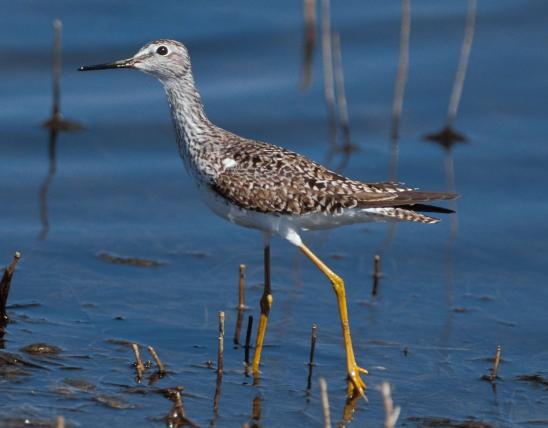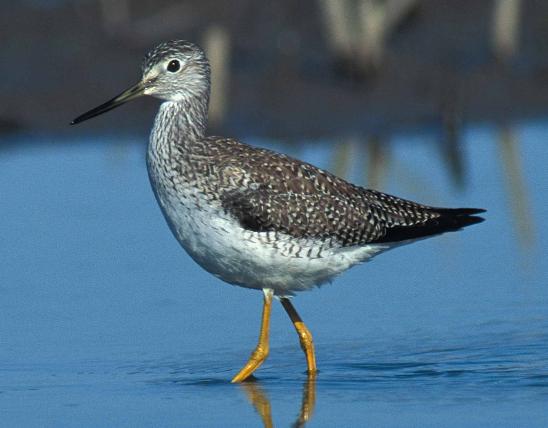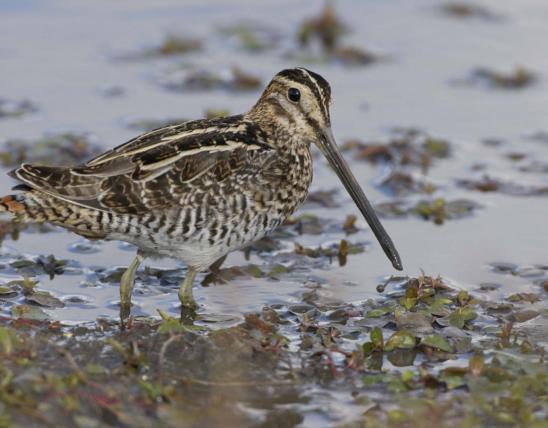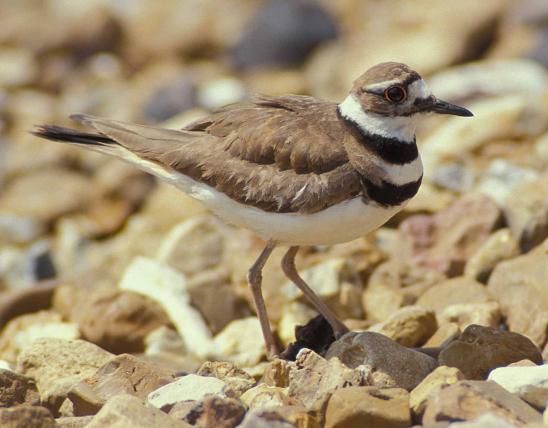
The pectoral sandpiper is dark brown-patterned above and clear white below, with dark breast streaks that end abruptly in midbreast. Nonbreeding plumage is grayer. The bill is slightly decurved (bent downward) and is usually lighter toward the base. The legs are yellowish. The voice is a low, harsh chirp.
Similar species: Sandpipers in genus Calidris are often called “peeps” or calidrids. They are very similar in shape, size, and coloration. The bill and leg color, bill shape, and wing length compared to the tail when standing, are usually critical for accurate identification of species. At least 12 species of Calidris shorebirds have been recorded for the state of Missouri, including the sanderling, Baird’s sandpiper, white-rumped sandpiper, semipalmated sandpiper, stilt sandpiper, least sandpiper, and dunlin.
Not counting other shorebirds (plovers, stilts, snipe, phalaropes, and so on), there are 26 species of sandpipers in Missouri. Sandpipers are the most difficult group of shorebirds to identify. Start by learning sandpiper subgroups — yellowlegs, godwits and curlews, peeps, and dowitchers — and by learning some of the easier species. You will soon learn the distinctive characters and behaviors that separate them.
Length: 8½ inches.

Statewide.
Habitat and Conservation
Like most other shorebirds, this species is found in the shallow waters of wetlands and on the margins of aquatic habitats. Most Missourians see pectoral sandpipers foraging on mudflats, shorelines, and flooded row-crop stubble fields.
Food
Like other Calidris sandpipers, the pectoral sandpiper forages on mudflats, shorelines, and flooded crop fields, probing the mud and plucking up aquatic insects, worms, and other invertebrates.
Status
Common transient (migrant). Accidental winter visitor.
Populations of pectoral sandpipers, like those of many other shorebirds, are declining. There are about half as many pectoral sandpipers in the world as there were in 1974. The causes for the decline are unknown, but researchers suspect that loss of critical wetland habitat along migration routes and in their Arctic breeding territory could be a cause.
Life Cycle
Pectoral sandpipers migrate through Missouri in spring and fall. In spring, they appear in the second half of March, their numbers peak in early May, and they have left by mid-June. The earliest fall migrants begin appearing in late July, their numbers peak in most of September, and they are gone by the beginning of November. In fall, the adults migrate south earlier than the juveniles.
Pectoral sandpipers breed in wet Arctic coastal tundra from the northern coast of Alaska east across Canada’s northern territories to Nunavut and the Canadian Arctic Archipelago. They arrive while there is still ice and snow on the ground.
Male pectoral sandpipers perform remarkable territorial and courtship displays in flight and on the ground. They claim territory by flying upward high in the sky with slow, fluttery wingbeats, then gliding down to the ground and strutting and dancing in front of females. Puffing out especially large air sacs in their chest, they produce a weird, hollow, pulsing song, something like cooing or hooting; in front of the female, they also make variety of squawking, gurgling, and other sounds. Males may mate with more than one female, and the males do not help in nesting or raising the young. Instead, they begin migrating south again.
Females create nests in simple depressions, usually on a ridge or other slightly raised area. They line the nests with grasses, mosses, and other soft vegetation. About 4 eggs constitute a clutch. Newly hatched young are covered with down and are active soon after hatching. When the young are old enough to fly, about 3 weeks after hatching, they and the females begin to flock and feed together in preparation for migration.
They spend winters in South America, in a broad territory stretching from the northern half of Argentina north through the rest of that continent, except for the eastern third of Brazil.
Human Connections
As with many other birds that breed in the Arctic, climate change seems to be affecting pectoral sandpipers. They seem to be spending more time in the breeding grounds, migrating through the United States earlier in the spring and later in the fall. Projections of a warming climate show nearly all of this species’ Arctic habitat eventually becoming unsuitable for them. Their current summer range, at the northern edge of North America, is already as far north as they could go.
As with most other shorebird species, the pectoral sandpiper used to be routinely hunted for food in the nineteenth century, causing population declines, but bird conservation laws enacted in the twentieth century curtailed overhunting.
The word pectoral refers to the breast or chest. This bird’s common name may refer to the location of the sharp color boundary between the dark-streaked breast and the white belly. The name might also refer to the enlarged air sacs in the male’s chest that enable him to make his haunting, hooting courtship songs.
In humans, the pectoral muscles fan across the chest from our shoulders to the breastbone. Some people call them “pecs.”
In birds, as you might imagine, the pectoral muscles are incredibly important for flying. When you eat chicken breasts, those are the chicken’s pectoral muscles. In chickens, however, the breasts are “white meat” because chickens don’t fly much; they can make quick, sudden, escape flights into tree branches, but they don't do long-distance flying. Because chickens’ breast muscles don’t need a steady, high stream of oxygen and therefore blood, they have a relatively light color. Meanwhile, in wild ducks and geese, the breast meat is darker than in chickens, because wild ducks and geese use their breast muscles for flying, and in many cases, migrating. Myoglobin is a protein molecule that binds oxygen to muscles and is present in red meat and in the darker meat of poultry. Considering that pectoral sandpipers fly from the Arctic clear to Argentina and back every year, what color do you think their breast meat would be?
Ecosystem Connections
Sandpipers are predators that eat insects and other small animals. Thus they help maintain balance in the populations of those animals.
A variety of animals prey on sandpipers and their eggs and young. Arctic foxes, bears, wolves, ermines, wolverines, owls, and eagles are some of the predators in Arctic ecosystems. They rely on the presence of their prey species to survive.
As a migratory species, the pectoral sandpiper plays a role in much of the Western Hemisphere, ranging from its breeding grounds in the Arctic to its summer home in South America — plus all the territory in between, including the United States. This is a good example of why effective conservation must involve international efforts.
Sandpipers characteristically have long, tapering, pointed wings, similar to those of falcons, swifts, and swallows. These make for efficient high-speed and long-distance flight.
Unless you travel to northern Canada or Alaska, you probably will never see the males’ courtship display in person. However, here in Missouri you can watch the display of American woodcocks, which is somewhat similar and no less spectacular.














About 350 species of birds are likely to be seen in Missouri, though nearly 400 have been recorded within our borders. Most people know a bird when they see one — it has feathers, wings, and a bill. Birds are warm-blooded, and most species can fly. Many migrate hundreds or thousands of miles. Birds lay hard-shelled eggs (often in a nest), and the parents care for the young. Many communicate with songs and calls.



























